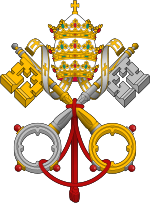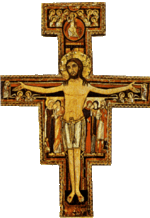Pope Pius I
| Saint Pius I | |
|---|---|
 |
|
| Papacy began | c. 140 |
| Papacy ended | c. 154 |
| Predecessor | Hyginus |
| Successor | Anicetus |
| Personal details | |
| Birth name | Pius |
| Born | c. late 1st century Aquileia, Italy |
| Died | c. 154 Rome, Roman Empire |
| Sainthood | |
| Feast day | July 11 |
| Other Popes named Pius | |
| Papal styles of Pope Pius I |
|
|---|---|
 |
|
| Reference style | His Holiness |
| Spoken style | Your Holiness |
| Religious style | Holy Father |
| Posthumous style | Saint |
Pope Saint Pius I was Bishop of Rome, according to the Annuario Pontificio, from 142 or 146 to 157 or 161, respectively.[1] Others suggest that his pontificate was perhaps from 140 to 154.[2]
Contents |
Early life
Pius is believed to have been born at Aquileia, in Northern Italy, during the late 1st century.[3] His father was called "Rufinus", who was also said to be of Aquileia according to the Liber Pontificalis.[4]
It is stated in the 2nd century Muratorian Canon,[5] and in the Liberian Catalogue,[6] that he was the brother of Hermas, author of the text known as The Shepherd of Hermas. The writer of the later text identifies himself as a former slave. This has led to speculation that both Hermas and Pius were freedmen.
Pontificate
St Pius I governed the Church in the middle of the 2nd century during the reigns of the Emperors Antoninus Pius and Marcus Aurelius.[7] He was the ninth successor of Saint Peter.[2] He decreed that Easter should only be kept on a Sunday. Although being credited with ordering the publication of the Liber Pontificalis,[8] compilation of that document was not started before the beginning of the 6th century.[9] He is said to have built one of the oldest churches in Rome, Santa Pudenziana.
St Pius I endured many hardships during his reign. The fact that Saint Justin taught Christian doctrine in Rome during the pontificate of St Pius I and that the heretics Valentinus, Cerdon and Marcion visited Rome at the same time, is a strong argument for the primacy of the Roman See during the 2nd century.[8] Pope Pius I opposed the Valentinians and Gnostics under Marcion, whom he excommunicated.[10]
There is some conjecture that he was a martyr in Rome, a conjecture that entered earlier editions of the Breviary. The study that had produced the 1969 revision of the Roman Catholic Calendar of Saints stated that there were no grounds for his consideration as a martyr,[11] and he is not presented as such in the Roman Martyrology.[12]
Feast day
St Pius I's feast day is celebrated on July 11. In the Tridentine Calendar it was given the rank of "Simple" and celebrated as the feast of a martyr. The rank of the feast was reduced to a Commemoration in the 1955 General Roman Calendar of Pope Pius XII and the General Roman Calendar of 1962. Though no longer mentioned in the General Roman Catholic calendar of saints, he may now, according to the rules in the present-day Roman Missal, be celebrated everywhere on his feast day with a "Memorial", unless in some locality an obligatory celebration is assigned to that day.[13]
References
- ↑ "Annuario Pontificio" (Libreria Editrice Vaticana, 2008 ISBN 978-88-209-8021-4), P. 8*
- ↑ 2.0 2.1 Catholic Encyclopedia: Pope St. Pius I
- ↑ "Lives of the Saints, For Every Day of the Year," edited by Rev. Hugo Hoever, S.O.Cist.,Ph.D., New York: Catholic Book Publishing Co., 1955, p. 263
- ↑ Ed. Duchesne, I, 132.
- ↑ Ed. Preuschen, "Analecta, 1," Tubingen, 1910.
- ↑ Ed. Duchesne, "Liber Pontificalis, I, 5."
- ↑ "Lives of the Saints, For Every Day of the Year," p.263
- ↑ 8.0 8.1 "Lives of the Saints, For Every Day of the Year," p. 263
- ↑ "Dictionnaire historique de la papauté", Philippe Levillain, Fayard 1994, p. 1042–1043"
- ↑ "Dictionary of Saints" (First Image Books Edition, April 2005 ISBN 0-385-51520-0), p. 505
- ↑ "Calendarium Romanum" (Libreria Editrice Vaticana, 1969), p. 129
- ↑ "Martyrologium Romanum" (Libreria Editrice Vaticana, 2001 ISBN 88-209-7210-7)
- ↑ General Instruction of the Roman Missal, 355 c
 This article incorporates text from a publication now in the public domain: Herbermann, Charles, ed (1913). "Pope St. Pius I". Catholic Encyclopedia. Robert Appleton Company.
This article incorporates text from a publication now in the public domain: Herbermann, Charles, ed (1913). "Pope St. Pius I". Catholic Encyclopedia. Robert Appleton Company.- "Lives of the Saints, For Every Day of the Year," edited by Rev. Hugo Hoever, S.O.Cist., Ph.D., New York: Catholic Book Publishing Co., 1955, pp 511
| Catholic Church titles | ||
|---|---|---|
| Preceded by Hyginus |
Bishop of Rome Pope 140–154 |
Succeeded by Anicetus |
|
|||||||||||||||||||||||||||||||||||||||||||||
|
|||||||||||||||||||||||||||||||||||||||||

